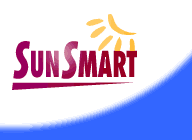|
Australian Skin Cancer
Australians
suffer the highest rates of skin cancer in the world. Each year, around 1,200
Australians die from what is an almost totally preventable disease. Everyone can
develop skin cancer; however, some people may be at higher risk than others, due
to a range of factors.
First launched by a cartoon seagull singing ‘Slip! Slop! Slap!’ on TV screens in 1980,
SunSmart adopted its name and mission in 1988. An initiative of The Cancer Council Victoria and supported by the Victorian Health Promotion Foundation, SunSmart was developed to combat spiralling skin cancer incidence and mortality rates. Since then, attitudes towards tanning and sun protection have changed dramatically. Australians have realised the pitfalls of their sun-loving, outdoor lifestyle and are taking preventative measures to reduce their risk of sun damage and skin cancer. Research by The Cancer Council Victoria shows SunSmart’s messages have reached a majority of Australians and had a stong impact on their behaviour. Consequently, skin cancer deaths have slowed and for females, have even started to decline. More Australians are detecting skin cancers early, increasing their chances of surviving the disease.
http://www.sunsmart.com.au/index.htm
|





